 |

| |
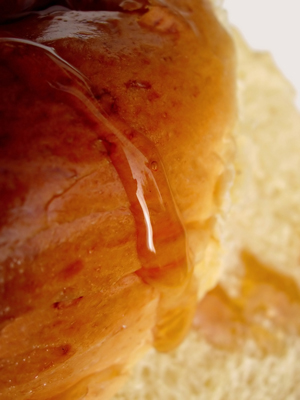 Time to give up the sticky generics and go for the greats: raw, varietal honeys (a.k.a. gourmet honey) from the internationally renowned beekeepers of Savannah Bee Company. Even this piece of challah knows it is more glorious with “the real deal.” Time to give up the sticky generics and go for the greats: raw, varietal honeys (a.k.a. gourmet honey) from the internationally renowned beekeepers of Savannah Bee Company. Even this piece of challah knows it is more glorious with “the real deal.” |
| WHAT IT IS: Rare, raw honey from Georgia and other Southeastern states. |
| WHY IT’S DIFFERENT: These are varietal honeys that are difficult or impossible to find elsewhere, produced by dedicated beekeepers who move their hives to the most remote areas to follow the nectar. |
| WHY WE LOVE IT: Purity of honey flavor, and the pronouncement of varietal flavor in each particular honey. If you eat honey regularly, these honeys will make you pause. They’re like discovering new favorite wines: even if you like what you were currently drinking, you know you have found something better. |
| PURCHASE AT: SavannahBee.com. |
|
|
 |

Savannah Bee Company Honeys: Queen Bee
Page 3: Honey Types ~ Black Sage, Sourwood, Tupelo & More
This is Page 3 of a five-page article. Click on the black links below to visit other pages.
INDEX
MORE TO DISCOVER
|
Types Of Honey
What’s it like when you taste your first spoonful of great artisanal honey? You’ll know when you taste these (and Savannah Bee Company sells a sampler, so you can taste all four currently available honeys):
- Black Sage Honey. The most rare of the honeys available at the moment, it relies on the flowering of the black sage trees. When we purchased a bottle last fall, the trees had not flowered for four years. This honey has a body that is utterly different from any other American honey; and distinct flavor notes of apple, berry and vanilla. It has a faint echo of tilleul, the famous and very costly French linden tree honey. Black sage honey never crystallizes, due to its high fructose to glucose ratio—which also means that it can be enjoyed more by diabetics.
Special Uses: While all of the honeys can be used for any purpose you like, black sage honey is a perfect companion for black tea. It enhances the tea without covering up the tea flavors.
- Orange Blossom Honey. Many people who have had orange blossom honey have not had the “orange grove” experience. A fine orange blossom honey will take you there, and Savannah Bee’s is an explosion of citrus on the palate, followed by hints of toffee and almonds.
Special Uses: Orange blossom honey is a favorite for toast, muffins and scones. We especially like this flavor drizzled on sweet potatoes.
|
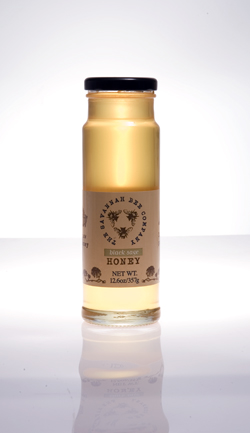
Black sage honey, shown above in the tower jar,
doesn’t crystallize; but any honey that has
crystallized can be heated in the microwave for 30
seconds, or in a pan of hot water for 10 to 15
minutes.
|
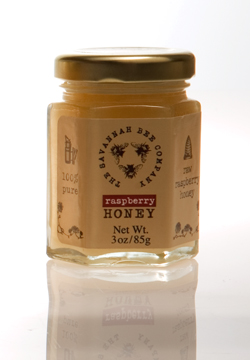
Cremed raspberry honey shown in the hexagonal
jar.
|
- Raspberry Honey. From wild raspberry bushes and made in cremed form, this honey tastes and smells like raspberry pie. One could eat it straight from the jar as a confection. Raspberry honey is sold in cremed form because of the high glucose content of the varietal: it crystallizes almost as soon as it is removed from the comb, so it can’t be sold in liquid form.
Special Uses: A dazzling spread for toast, biscuits and scones—something to make brunch extra-special.
- Sourwood Honey. There has been no sourwood honey for a few years,† so mark your calendar for September when it returns—demand always exceeds supply. The gingerbread flavor is ethereal: a sweet, spicy, anise aroma with hints of maple and a warm finish. Had we known we were not to have it again for a while, we would not have been so generous, encouraging all of our friends to “taste this!” Like black sage honey, sourwood honey does not crystallize.
Special Uses: We used it as an ice cream topping and spread it on pound cake and gingerbread. The flavors match with Asian foods and green teas, both hot and iced.
†Sourwood is an understory tree that often doesn’t get enough sunlight to produce nectar for the honey. The last three years have been extremely difficult; cloudy, cool weather in the spring have produced blossoms, but not enough nectar. There was about 30% of an average yield last year in North Carolina, and other states, including Georgia, had none at all.
|
- Tupelo Honey. Savannah Bee Company considers their tupelo honey the “gold standard” of honey. It is produced from the flower of the tupelo gum tree, also known as the water tupelo, which grows in the rivers and swamps surrounding Savannah. The trees flower for just three weeks a year, in April. This light amber-colored honey has unique flavor notes of melon, crème brulée, butter and dried pear, with a very subtle herbaceous undertone of southern moss. With this kind of complexity, it is becoming one of the most popular table honeys for connoisseurs. Tupelo honey also does not crystallize. It is the only honey to be immortalized in music and film: in a 1971 song and album of the same name by Van Morrison; and the 1997 film Ulee’s Gold, starring Peter Fonda as a beekeeper whose “gold” is his tupelo honey.
Special Uses:
This is the all-purpose honey in the line of great honeys—for tea, toast or dribbled over a piece of aged Cheddar.
|
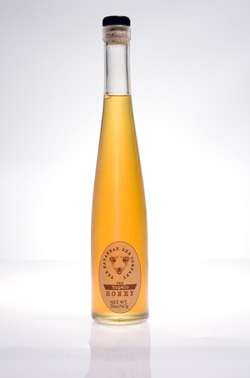 Tupelo honey shown in the tall flute. Tupelo honey shown in the tall flute.
|
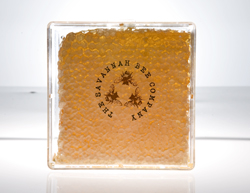 Honeycomb. Honeycomb. |
Honeycomb. Some people enjoy their honey from the comb, and Savannah Bee Company obliges with a beautiful 4-inch-square honeycomb of rare Georgia honey, beautifully packaged. The honey is typically from white holly or saw palmetto blossoms. The wax is edible (it’s the adult version of the chewy wax liquid-filled candies of childhood).
Special Uses: The comb makes a beautiful presentation on a brunch table or cheese board.
What else can you do with your fine honeys? The answer is on the next page.
|
Continue To Page 4: Honey Serving Tips
Go To The Article Index Above
Do you have friends who would enjoy THE NIBBLE?
Click here to send them an invitation to sign up for their own copy. |
ABOUT THE NIBBLE. THE NIBBLE™, Great Finds For Foodies™, is an online magazine about specialty foods and the gourmet life. It is the only consumer publication and website that focuses on reviewing the best specialty foods and beverages, in every category. The magazine also covers tabletop items, gourmet housewares, and other areas of interest to people who love fine food.
© Copyright 2004-2025 Lifestyle Direct, Inc. All rights
reserved. All information contained herein is subject to change at any time
without notice. All details must be directly confirmed with manufacturers, service
establishments and other third parties. The material in this newsletter may not
be reproduced, distributed, transmitted, cached, or otherwise used, except with
the prior written permission of Lifestyle Direct, Inc.
|
 |
|
 |





 Time to give up the sticky generics and go for the greats: raw, varietal honeys (a.k.a. gourmet honey) from the internationally renowned beekeepers of Savannah Bee Company. Even this piece of challah knows it is more glorious with “the real deal.”
Time to give up the sticky generics and go for the greats: raw, varietal honeys (a.k.a. gourmet honey) from the internationally renowned beekeepers of Savannah Bee Company. Even this piece of challah knows it is more glorious with “the real deal.” 

 Tupelo honey shown in the tall flute.
Tupelo honey shown in the tall flute. 